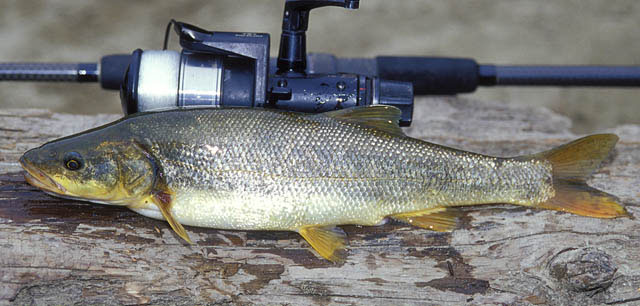| Leuciscidae (Minnows), subfamily: Laviniinae |
| 63 cm TL (male/unsexed); max.weight: 13 kg; max. reported age: 11 years |
|
benthopelagic; freshwater |
| North America: Pacific drainages from Nass River in British Columbia, Canada to Columbia River in Nevada, USA; Harney River basin in Oregon, USA; Peace River system (Arctic basin) in British Columbia and Alberta, Canada. |
|
Dorsal soft rays (total): 9-10; Anal soft rays: 8-9; Vertebrae: 44-46. Mot deep bodied, greatest depth 16.6% (TL), belly gently rounded in mature individuals. Head moderately long, its length 22.8% (TL); eye small in adults, 17.6% of head length, but larger in young 7.6 cm long, when 25.2% of head length; snout long, 33.1% of head length of adults; interorbital width 29.6% of head length; mouth large, extending back to below anterior margin of eye. All fins clear. Pelvic axillary process usually a ridge. Peritoneum present. Nuptial tubercles fine, on head and back, on pectoral and pelvic fins and sometimes on the caudal fin. Dark green or green-brown dorsally becoming silvery white or cream ventrally. The lower fins of the males become yellow or yellow-orange during spawning period (Ref. 1998). Dorsal fin usually with 9 rays; anal fin with 8 rays; 48-72, usually 51-62, scales on back from head to dorsal fin; 64-79, usually 66-75, scales on lateral line; and 12-20 scales above lateral line (Ref. 86798). |
| Found in lakes, pools and occasionally in runs of small to large rivers. Large individuals occur in deep water (Ref. 5723, 86798). Feeds on fishes, terrestrial insects, plankton, aquatic insect larvae, and crustaceans while inshore; feeds mostly on fishes while offshore (Ref. 1998). Male squawfish, prickly sculpins, and newts prey on the eggs (Ref. 1998). Edible but not well appreciated (1998). |
|
Least Concern (LC); Date assessed: 01 March 2012 Ref. (130435)
|
| harmless |
Source and more info: www.fishbase.org. For personal, classroom, and other internal use only. Not for publication.

